A strategy game is not only about battles; it also involves your attention to economic matters. Sins: Rebellion had some economic differences between factions, but Sins II takes asymmetric economic styles to a new level.
For those familiar with Sins: Rebellion’s economy, the TEC will have the least surprises in Sins II. Meanwhile, the Vasari’s economy has been fully reworked, as they now have little use for credits. Due to this, we will need to treat each race separately.
If you are completely new to the game, please make sure to read our Getting Started Guide.
Economy basics
Therefore, your goal is to expand as much as possible and you do that by colonizing planets. Each planet is defended by neutral militia, so you will need to build some ships even before you engage your main opponent. Some planets are so heavily defended that you may require a mid-game fleet just to be able to take on them.
There are 3 types of main resources: Credits, Metal and Crystal.

The icons are new, but the concept is same as in the previous game. Credits are a universal currency used in large masses (unless you are Vasari). Metal is used more heavily in ship construction and crystal is used more heavily in research.
Credits
The main source of credits are planets. Planets no longer have population; instead, they feature Commerce infrastructure upgrades. This means you do not need to wait for your population to grow in order to increase your credit income.
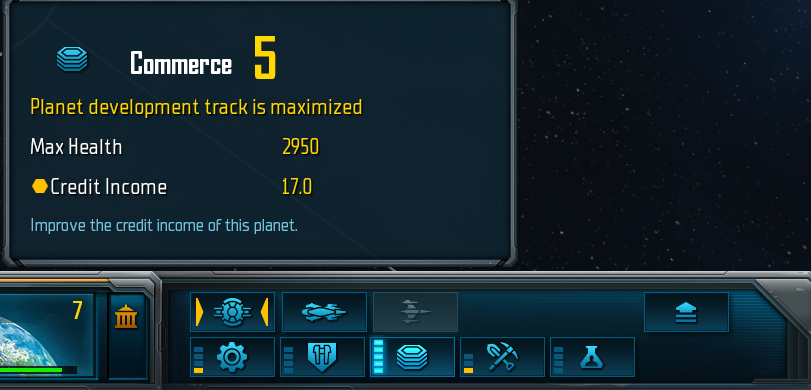
Our Homeworld can provide 17 credits/second, when fully upgraded
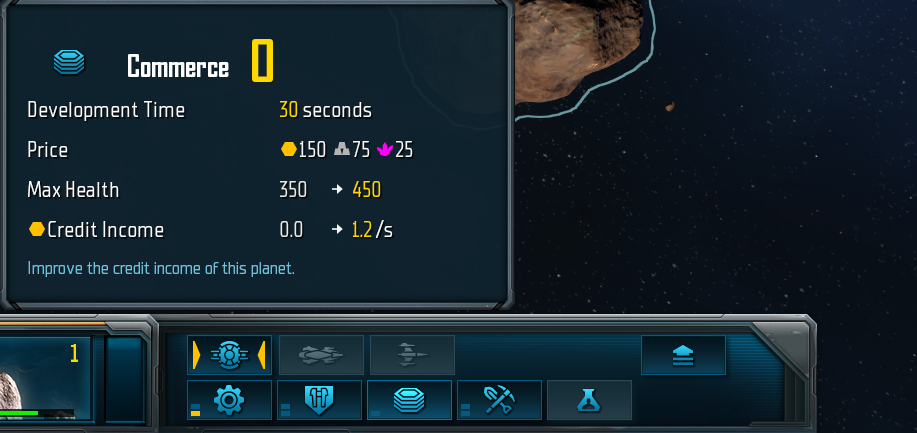
While an asteroid sits at mere 1.2 credits/second.
As you can see above, different planet types have different amounts of max income. This may, and even should, influence your decision making on which planet to colonize next and how to utilize them.
There is no longer a penalty for an underdeveloped planet. This means, if you forget to upgrade your Commerce, you will not be penalized for it. You can always colonize a planet and upgrade it later, should you lack the resources. Such a planet will simply generate 0 resources, but also take none.
Fleet supply no longer reduces your income by a tax: you can go for 2000 supply without a second thought about malus for your economy. However, there is a new mechanic called “infrastructure cost”, which reduces your income as your empire grows. You will not be able to indefinitely scale your economy, but should you lose your planets, the “infrastructure cost” is dynamic and will fall along with your income.
Both TEC factions also have access to trade, which we will handle later on.
Metal & Crystal
Let’s talk about planetary income first. Just as with credits, the actual income varies on planet type. An ice planet will provide pure crystal income, while volcanic planet will provide exclusively metal. Some planets will have mixed income but usually with a shift to metal, like asteroid planet in the example:
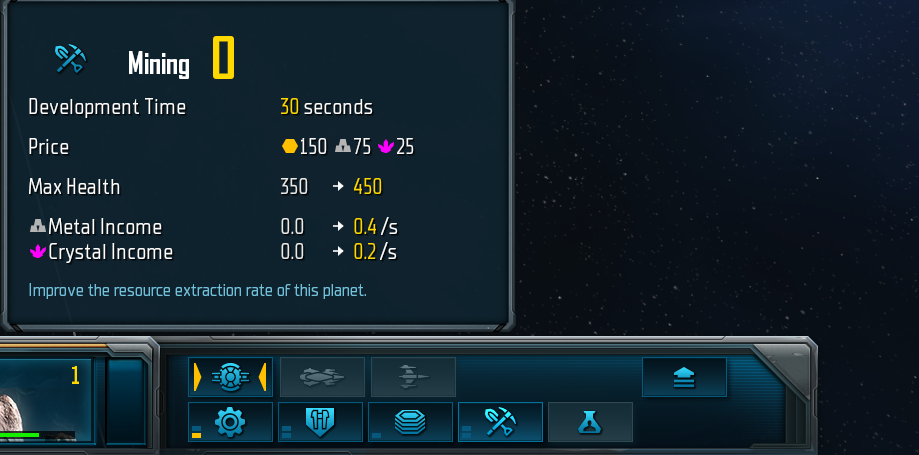
It is also worth noting, that Vasari miss commercial upgrade track on their planets, but instead they have more levels to planet mining. This also differs on planetary basis, e.g. asteroids will have same amount of upgrades for all factions, but bigger planets will have more levels.
So what about orbital extractors? Why bother with them, if a planet can provide the resources through planetary mining.
The answer is, that orbital mining is just better, and once you have the technology to unlock it, you do not need to chose between the two, you can get both!
Overall orbital extractors will require higher investment, but in return you will get a better deal of maximum economy on the same amount of planets. Going “wide” often makes you vulnerable, especially in FFAs, with orbital extractors, you can stick to your initial planets, and build a formidable defense, instead of stretching your empire and end up falling like a house of cards.
This system also ensures that building mining extractors is no longer a trivial thing you just do based on memory muscle, but a strategic decision you make, if you have the capabilities to build a mining extractor, which will boost your economy, but also require a substantial investment.
Treat extractors as a mid game economic tool, and your empire will flourish.
Planetary Upgrades
No!
Sins II mechanics ensure you do not have to do repetitive mindless tasks: It’s always about strategic decisions. These decisions are tied into how planetary upgrades work. Particularly, how the cost scales. It’s no longer individual for each upgrade, but the same cost for any type of upgrade.
Let’s look at an example: At the beginning of the game, our TEC homeworld has level 2 in Commerce and level 1 in Mining. If we were to upgrade commerce to next level, we would have to pay 150 credits/175 metal/25 crystal:
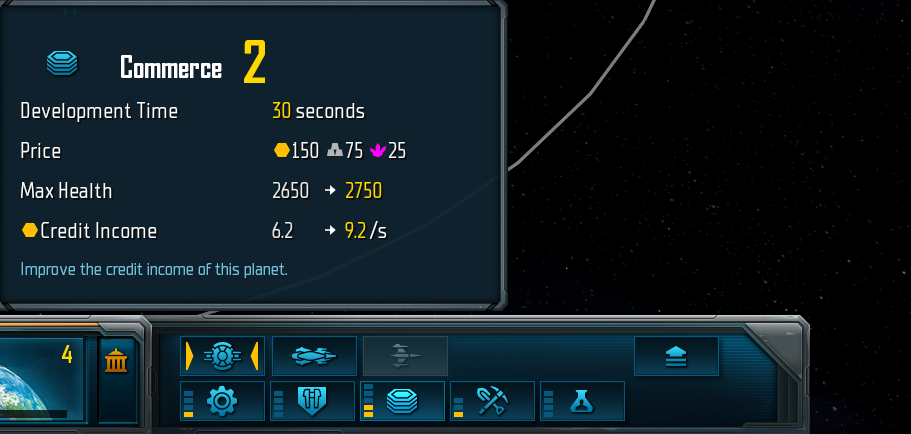
If we were to upgrade Mining to next level, we would have to pay… the same number of resources!
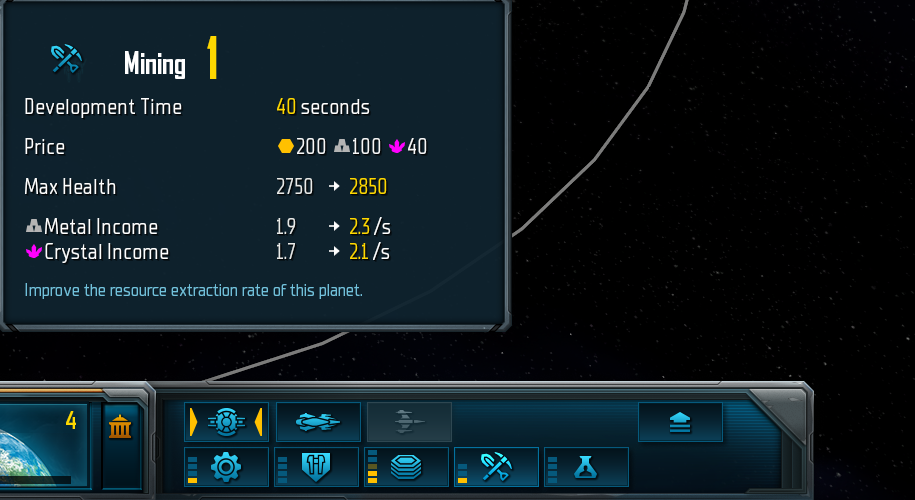
Even upgrading Defense from level 0 to level 1 costs the same:
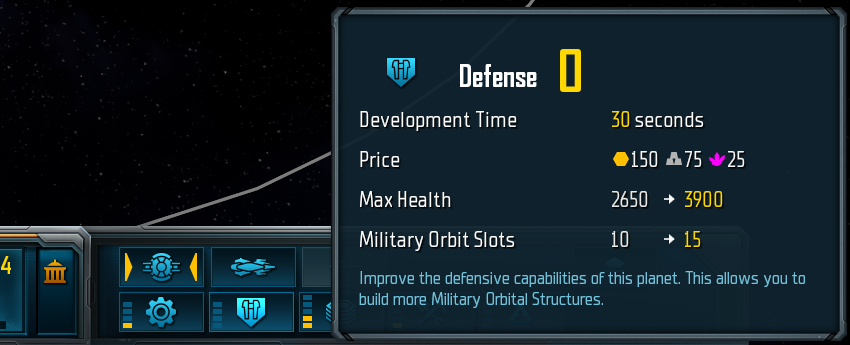
Now if we were to make any upgrade – any following upgrade would cost more. Look how I am upgrading Commerce to level 3, but Mining level 2 increased in cost:
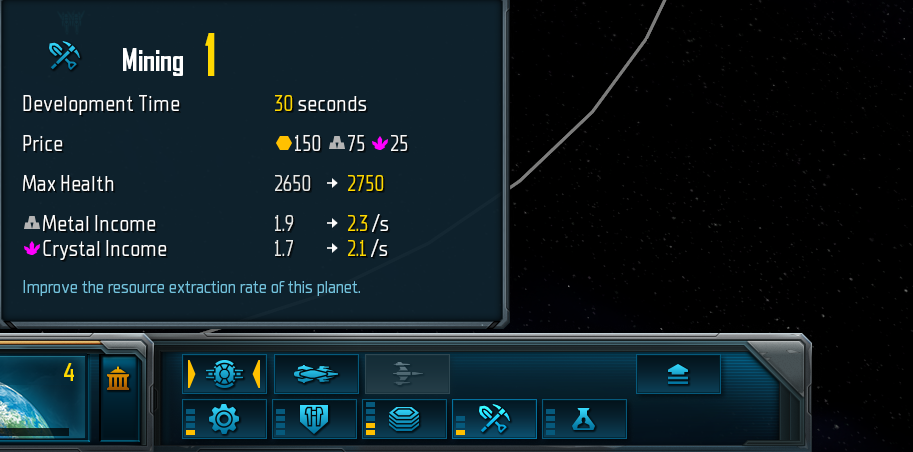
So how do you do it? Well, the beauty of this system is that now your global strategy decides. You want to go heavy on technologies? Skip Commerce and prioritize Mining. Need more logistic slots for factories? You cannot also go for income on that planet easily.
There is also the factor of planet types. As mentioned earlier, a fully upgraded homeworld can provide 17 credits/second for TEC, while an asteroid will max out at 1.2. In the early game you will struggle to colonize other credit heavy planets (such as terran or desert), because of militia, and naturally will expand to asteroids.
This means that the rule of thumb for the early game for TEC/Advent is to maximize Commerce on your homeworld, before you upgrade Mining. Should you find yourself in need of metal or crystal, you should colonize more asteroids and upgrade the Mining there.
Vasari have no use for credits, but their game plan is even more so defined by balancing metal and crystal income. Heavy metal income will boost your military production, while crystal is required for research. However you still need crystal in military production, so that crystal is a far more common bottleneck, than metal. And since your homeworld is poor on crystal, you should prioritize crystal rich planets, such as ice or crystaline planets – unless you are going for some hard all in.
Exotics basics (new resource)

Exotics are used for high end technology, capital ship modules, planetary modules, starbases, capital ships and titans. So, everything related to more sophisticated parts of the game, and this makes them very precious.
Every single capital ship requires 2 exotics in different combinations. This means you have to choose your first capital ship wisely, as you will not be able to change to a different capital ship until you acquire more exotics.
There are 4 ways of getting exotics: first is to produce them through refineries; second is to gather them through derelict loot (if you do not know, what derelict loot is, you can read on those in our “Getting started” guide); third is through planetary excavation and fourth is via auctions from minor factions.
Refineries are either tier 2 or tier 3, depending on your race. The basic exotics cost only 400 credits/125 metal/125 crystal for TEC/Advent or 0 credits /225 metal/225 crystal for Vasari. This may make it sound like an easy grab, but exotics are only parts of your production and take a long time to ‘build’. In a global scope, setting those up too early may mean too few ships, too slow expansion and losing the game.
Exotics take 120 seconds to produce, so a single refinery will be enough until late game. Mostly you will need 1 exotic for an item or 2 exotics for a capital ship. You can also see individual items unlocked by a specific exotic by hovering your mouse over it, like here we do for Tauranite:
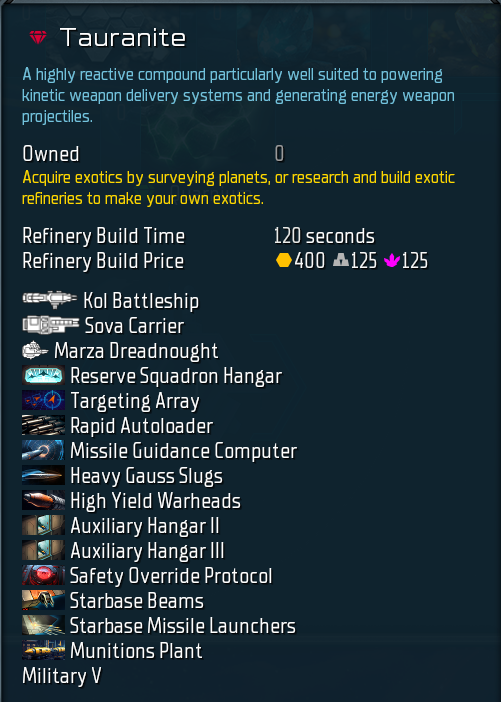
This list is quite long, but you do not need to memorize it, as the game automates a lot of process for you, including queuing up exotics in your refinery, whenever you order an item, which requires it.
Quarnium stands out from other exotics, as it is a late game exotic, required for titans and some super late game technology. The full list of unlocks by Quarnium is significantly smaller, however you can directly see, that it’s necessary for he most sophisticated inventions existing.

TEC – Trade Specialists
Not surprisingly, the TEC make use of trade. If you are familiar with Sins: Rebellion, do not be quick on skipping this part, as trade got a major rework.
First of all, let’s look at the trade menu:
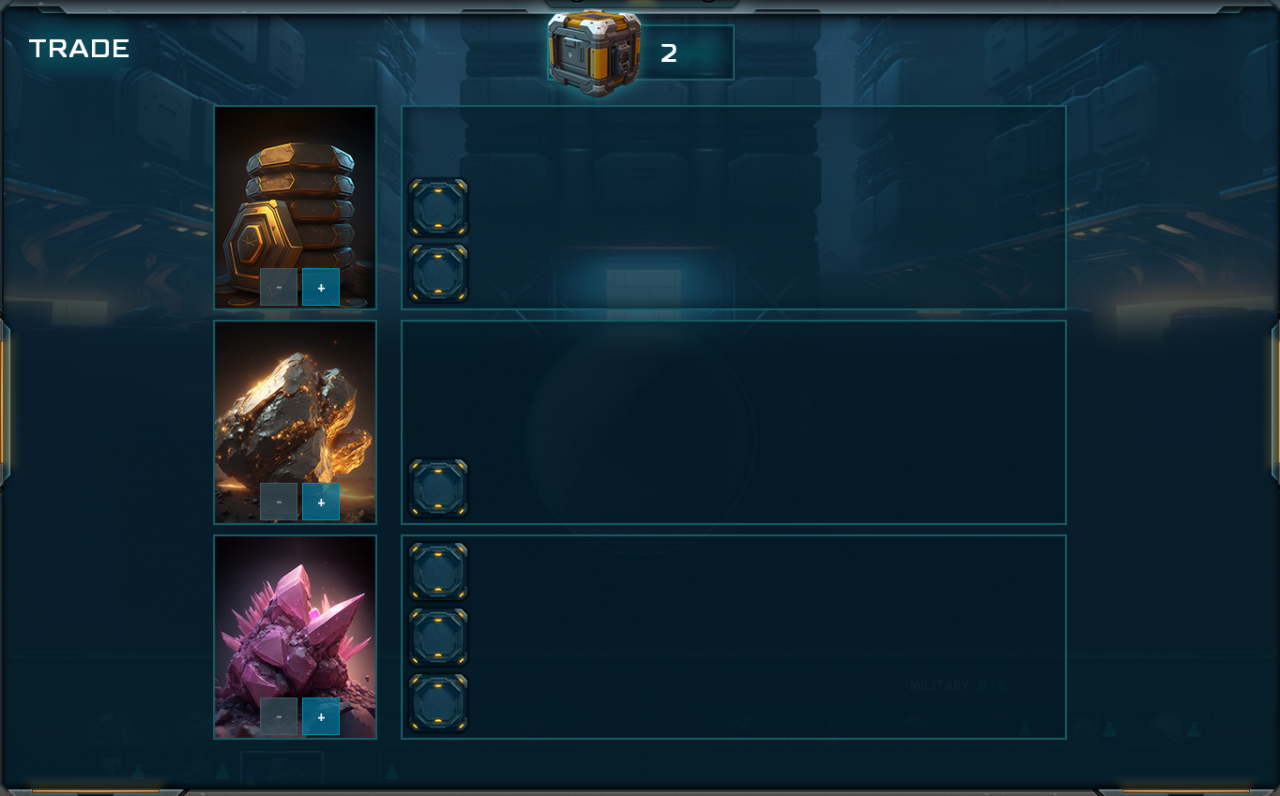
You can see that there are 3 fields. This is because trade can now generate metal and crystal, along with credits. But you have to make a decision on what you want to produce.
In this specific screenshot you can see that I have 2 “export points”, and different amount of slots in each field. This happened because I have 1 trade port at my homeworld and 1 at my ice planet. Do note, that I have 2 export points, but only 1 slot in metal, meaning that I could not allocate everything to metal, even if I wanted to.
Should I assign my export point to credits it will generate 2 credits/sec:

Should I assign the same export point to crystal, it will generate 1 crystal/sec (and no credits):

This means a conversion rate of 2-to-1 between crystal and credit. If you were to produce pure credits, and then buy crystal on the market, you would face a 3x price mark up. This shows that properly managing your trade economy can double your actual yields.
Now let’s dive into the mechanics of export slots.
At start of the game, you will sit at 0, both export slots and allocation slots for all 3 resources. There are 2 ways to get export slots. The first is the simplest – upgrade the ability on your Akkan:
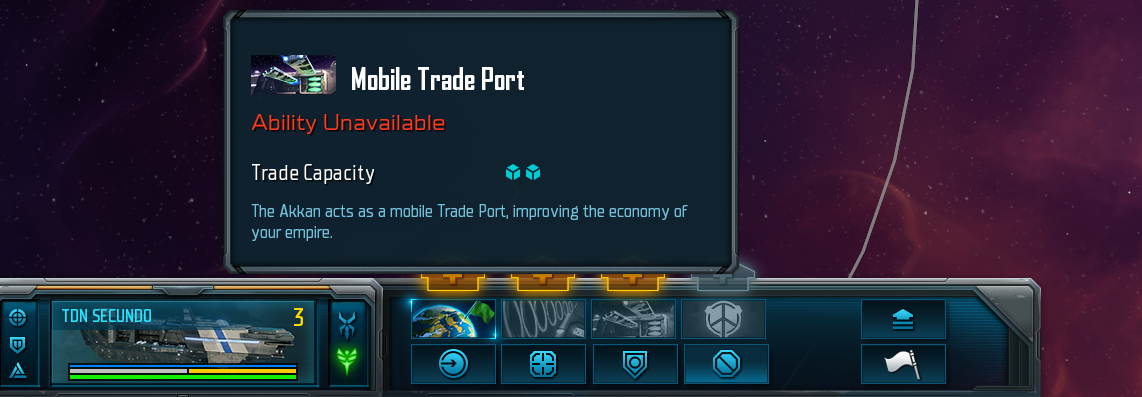
Each level gives 2 export points. So, at level 3 of the ability you would have 6 export points (equal to 12 creds/sec). You will have to give up on the fleet boosting ability until later, but this will turn your Akkan into an absolute economy powerhouse.
The second way is through building trade ports. Each trade port will give you an export point.
However, getting export points is just half of the job. You also need to find a way to sell those goods, aka create allocation slots. This is an entire minigame in itself, because each planet type provides different trade allocation slots.
We will compare our homeworld:

To an ice planet:

You can instantly see the difference in trade capacity. What this means, is that an ice planet can house up to 3 trade ports, while your homeworld can house up to 5 trade ports. (Don’t worry, the game will not allow you to build more than the allowed trade ports, so you cannot make a mistake here.)
But there is more to it. If we look closer into our homeworld’s trade capacity, we will see these icons:
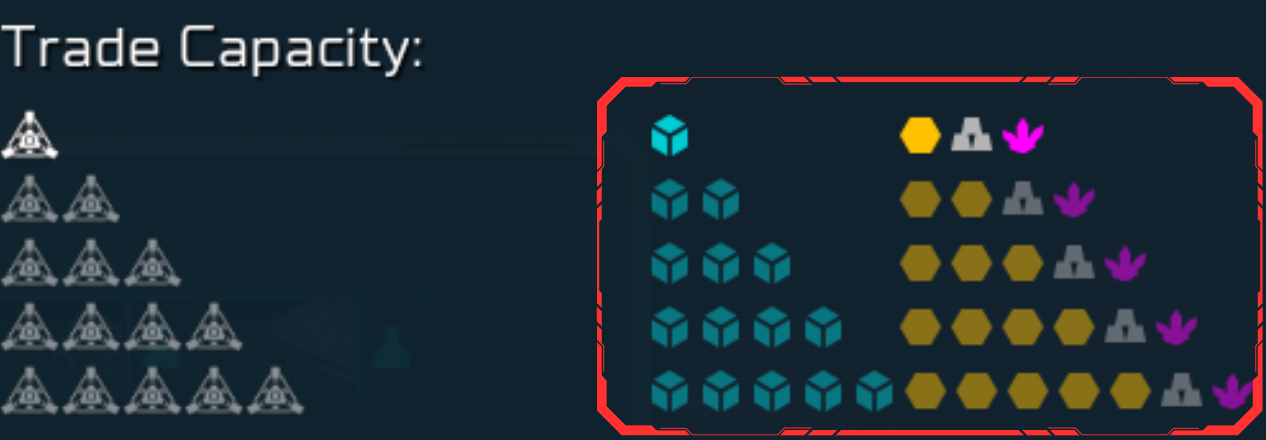
Those icons represent amount of allocation slots you will be getting:
- At 1 trade port you will get 1 export point along with 1 allocation slot in credits, metal and crystal.
- At 2 trade ports you will get 2 export points along with 2 allocation slots in credits, 1 allocation slot in metal and crystal.
- At 3 trade ports you will get 3 export points along with 3 allocation slots in credits, 1 allocation slot in metal and crystal.
- At 4 trade ports you will get 4 export points along with 4 allocation slots in credits, 1 allocation slot in metal and crystal.
- At 5 trade ports you will get 5 export points along with 5 allocation slots in credits, 1 allocation slot in metal and crystal.
This means that if you are low on credits (which you will be in early-midgame), your homeworld (or any other Terran) will be a perfect planet for trade.
If we go back to our Ice planet screenshot, you will also see that asteroid has 0 metal allocation slots. So, getting a trade port at an Ice planet will never provide you with an extra metal slot. For this reason, you should watch carefully which planet you use to build trade ports.
In early-midgame what you want to do is to increase your credit income. This can be done best with Terran or Desert planets. Terrans are your homeworld type, so they are better, but if you see a Desert, make sure to grab it. Not only is it almost as good as a Terran, you will also deprive an Advent player from their best economy planet.
In the topic below you can find all planet types and their trade points.
PRO TIP: If you scout minor factions, they will provide a few allocation slots. This allows for some sneaky strategies with Akkan, as the Akkan provides only export points, but no allocation slots. However, if you were to quickly scout a minor faction, you could get your income rolling, even before you research trade ports.
Trade Points Cheat Sheet

Asteroid:

Ice:

Volcanic:

Desert:

Ferrous:

Gas Giant (YES, they are colonizable!):

Oceanic:

Crystaline:

Primordial:

Vasari Economy
Well, almost no use. They can use them for auctions, markets or send them to allies, but that’s pretty much it.
NOTE: The Vasari Alliance also has an extra planet module (Intercultural Exchange) to generate credits:
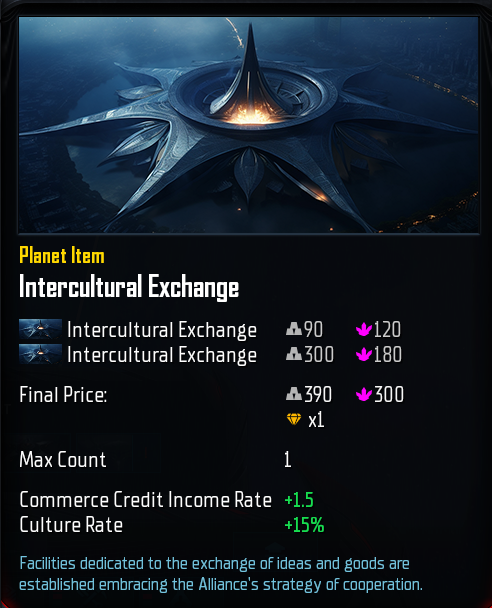
This means Vasari players only have 2 main resources – metal and crystal; and your “Commerce” planetary upgrade is disabled. You may think it’s easier to manage if you only have 2 resources, but actually it may be the opposite. Every market transaction happens at a bad ratio for you. But since market transactions are dealt in credits, you will always have to do 2 market transactions, when you try to convert one resource into the other one. Also, you cannot compensate by simply readjusting trade points since the Vasari don’t trade. You have to plan your economy much more carefully than the TEC.
You do have more starting resources, so you shouldn’t bottleneck in the early game. But since your homeworld has rather bleak income, some 20 minutes into the game, you may get into economic troubles unless you proceed carefully.
Starting Vasari resources:
![]()
NOTE: Vasari start on a ferrous planet which only has metal from its Mining upgrade, and metal extractors. But you still have some 2 crystal/second, because those are provided from the capital upgrade.
Vasari need much more crystal than their capital planet provides, as their technology relies on it and not even Ravastras are made purely out of metal. Even though orbital extractors are a tier 2 technology, with your starting funds, you can rush this technology, and begin establishing crystal orbital extractors.
You may go as far as colonizing ice planets, which are rather uninteresting for TEC players, if you find yourself low on crystal.
You should also research respective income technologies, but be careful, as planetary mining, and extractor mining are two different technology paths.
Orbital Extraction Rate buffs your extractors. So go for it, if you manage to build them in significant amounts:
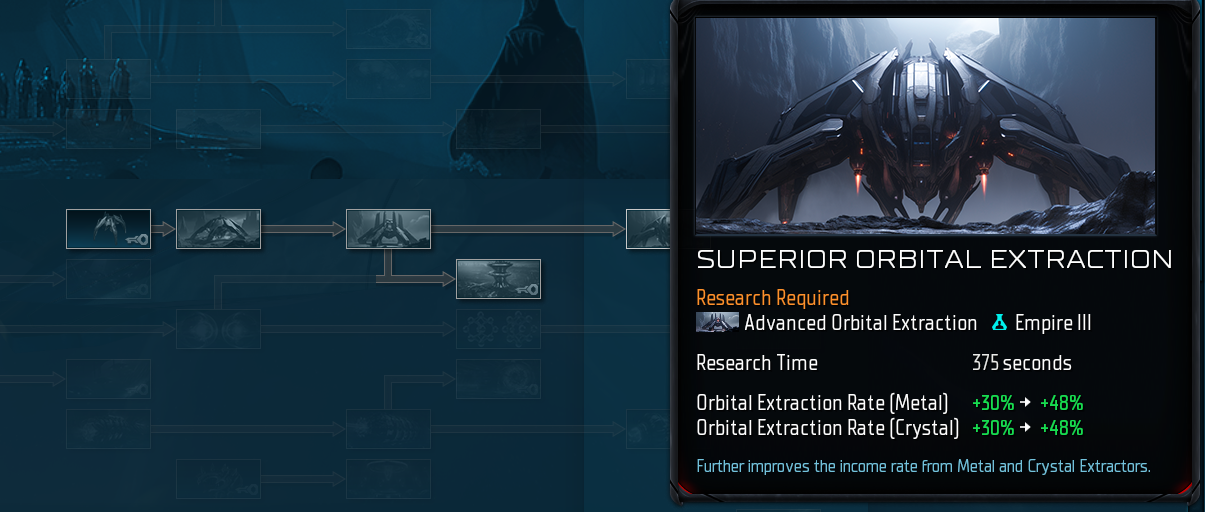
Meanwhile “Surface Mining Rate” is the one which buffs your planetary mining upgrades.
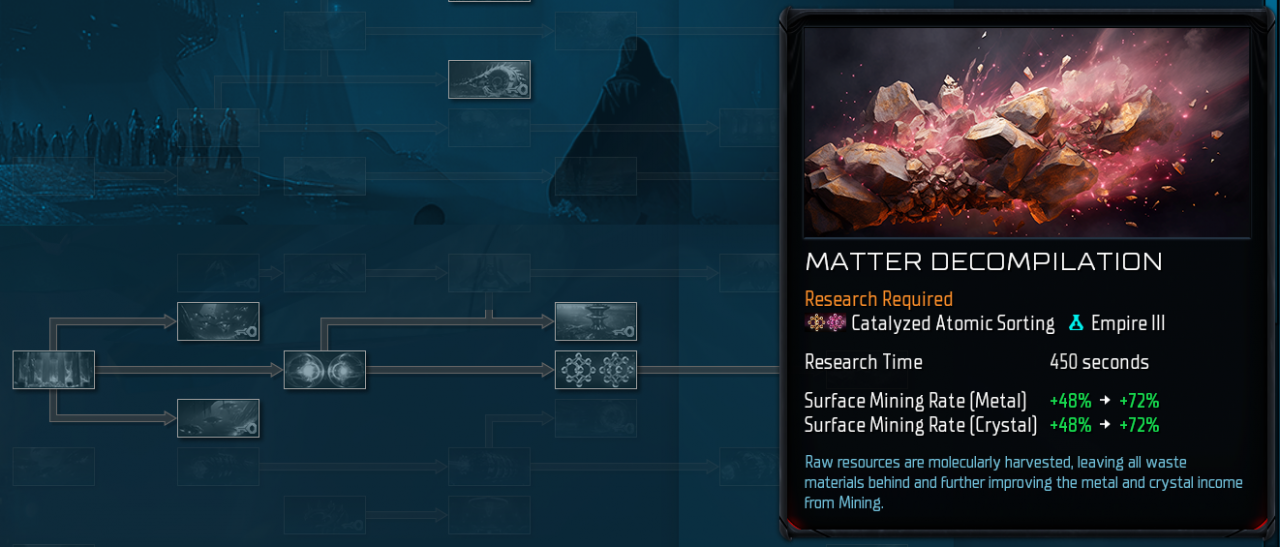
When making a decision to build an extra extractor, or upgrade planetary mining, the rule of thumb is to go with the extractor. It has a better price to yields ratio in most cases. But keep an eye on planetary bonuses such as the one below:
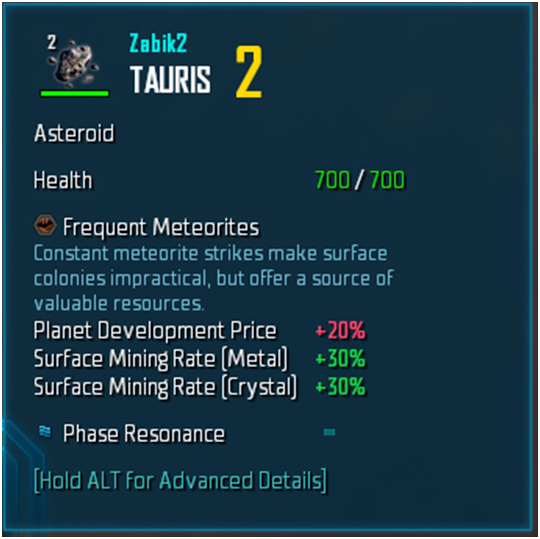
With 30% extra surface mining income it’s much more efficient to upgrade the planetary mining first.
Another semi-unique feature for the Vasari is that they start with 8 exotics. In theory this allows you to build 4 extra capital ships without the need to research the refinery. If you are trying some cheese strategies with capital ships, this may give you a huge advantage in timing.
This also means, you can support your TEC ally in team games with early exotics, if your ally wants to go for more capital ships. Furthermore, your “Quarnium” is just tier 3, making titan rushing more viable, than it is for other factions.
This sums up the overall Vasari economy, but we still have to talk about the Vasari Exodus.
Vasari Exodus – The Space Nomads
It is a tier 4 technology, which requires 15 labs at the minimum. Tier 4 also requires the “Kalanide” exotic, but at that point you will have them in big quantity. Still, you cannot rush the technology from the start of the game, as tier 4 is no joke for your economy. It will be a great addition to your mid- or late game, as STTC does not only provide a short-term economy boost, but also allows you to destroy enemy planets for good.
ATTENTION: It is not enough to abandon the planet, as you did in Sins: Rebellion. You now need to install an STTC planet module before doing so. This may look like an extra button click; however it gives you more freedom as you can abandon planets without destroying them.
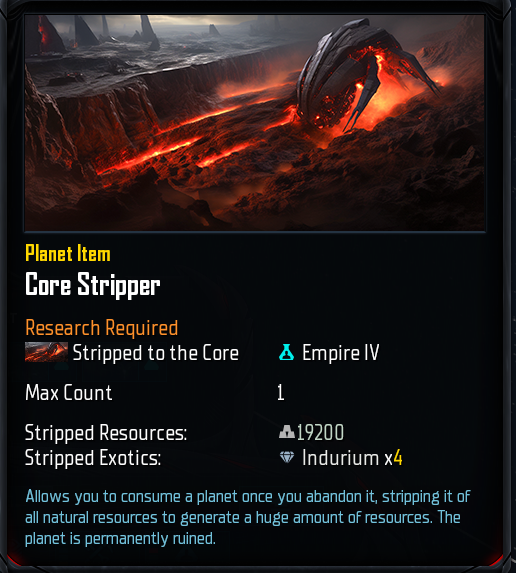
Every planet type provides a different set of resources, with bigger planets providing more resources.
Should you decide to STTC your own planets, it will give you a major boost for the one final push, but at the same time it means that you have to win in that single push – bringing the “all in” strategy to a new level, as you are physically destroying everything.
STTC in process:
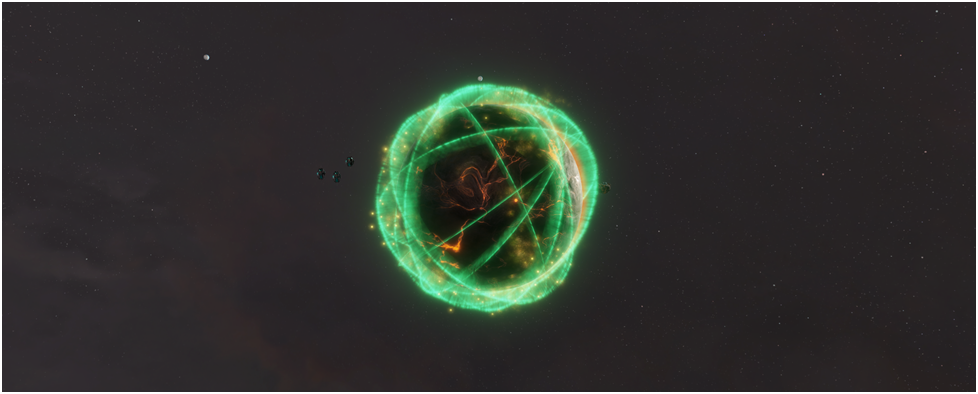
There is no rule of thumb here, but you can make your decision based on the cheat sheet below.
STTC Cheat Sheet
Cost for technology is not included. Cost for planet module is included.
What we can see is that using STTC on a pirate base is the easiest decision, while using it on an asteroid will be good only in niche situations. Furthermore, the actual benefit in time will likely be higher in a real game, because planets rarely have the max number of extractors.
Advent Economy
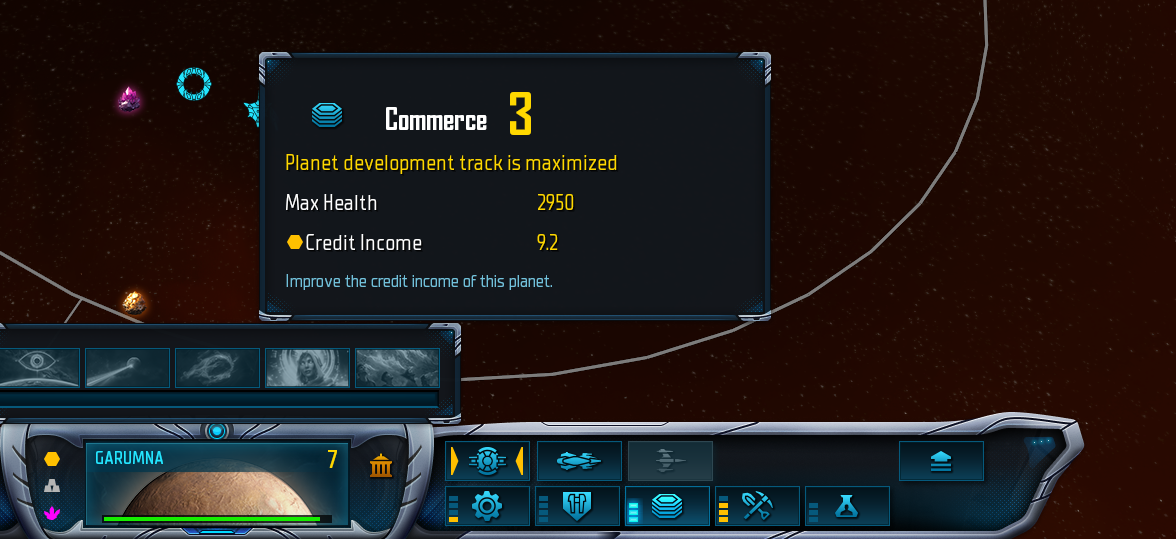
Instead Advent get more planetary mining. However Advent also have a variety of boosts to their deserts. Including an early game credit income boost from tier 1 in civilian tree:
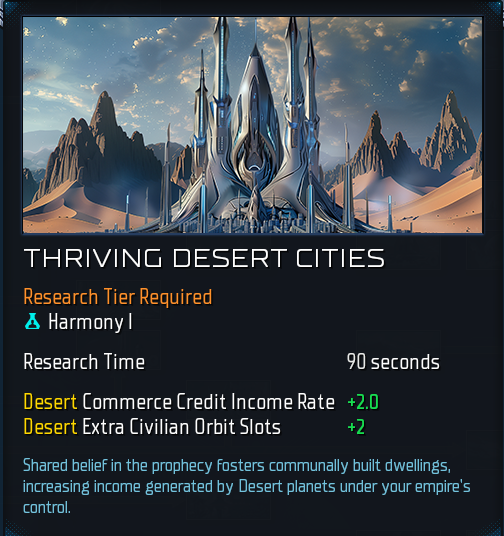
Later on, they can continue boosting their commerce income with planetary items, such as Sanctuary spire, as +50% is quite a lot:
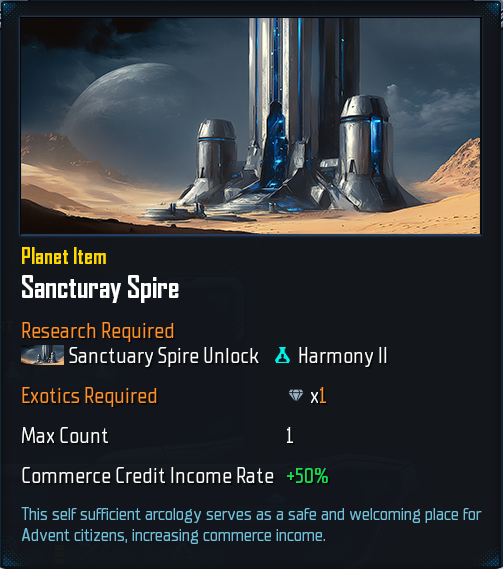
Advent will usually swim in crystal, especially because of their culture boosting this specific resource. But worry not, you will not be scammed at the global market! As Advent you can “transmute” crystal in both credit and metal with specialized planetary item:
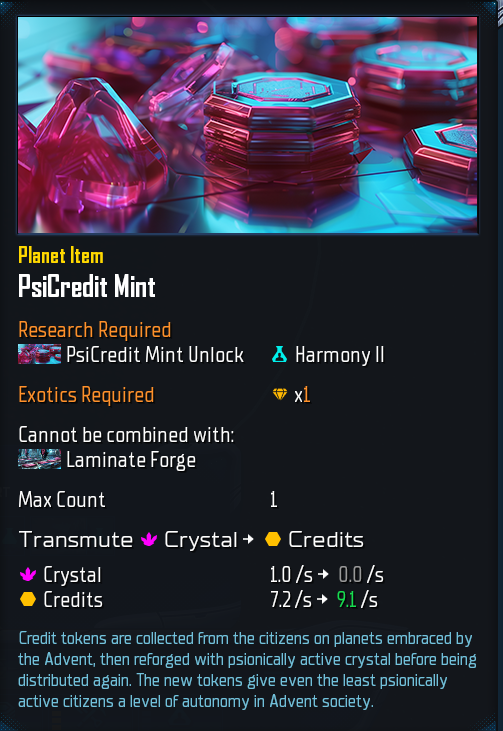
Those items offer you a much better conversion rate, than the market, and are equal to the yields of trade. Planetary items are obviously less flexible than the export points, but those modules offer you to show great planning skills, while optimizing your economy.
Overall Advent do not fall behind in economy, up until late game, when compared to TEC. However your economy requires more fine tuning and planning. In return, your strength lies in powerful Unity abilities, culture, and strong synergies between your ships.
More Guides:
- Sins of a Solar Empire II: Planet Modules Guide
- Sins of a Solar Empire II: Vasari Alliance Multiplayer Quick Guide
- Sins of a Solar Empire II: Capital Ships Module Guide
- Sins of a Solar Empire II: Multiplayer Guide
- Sins of a Solar Empire II: Combat Guide
